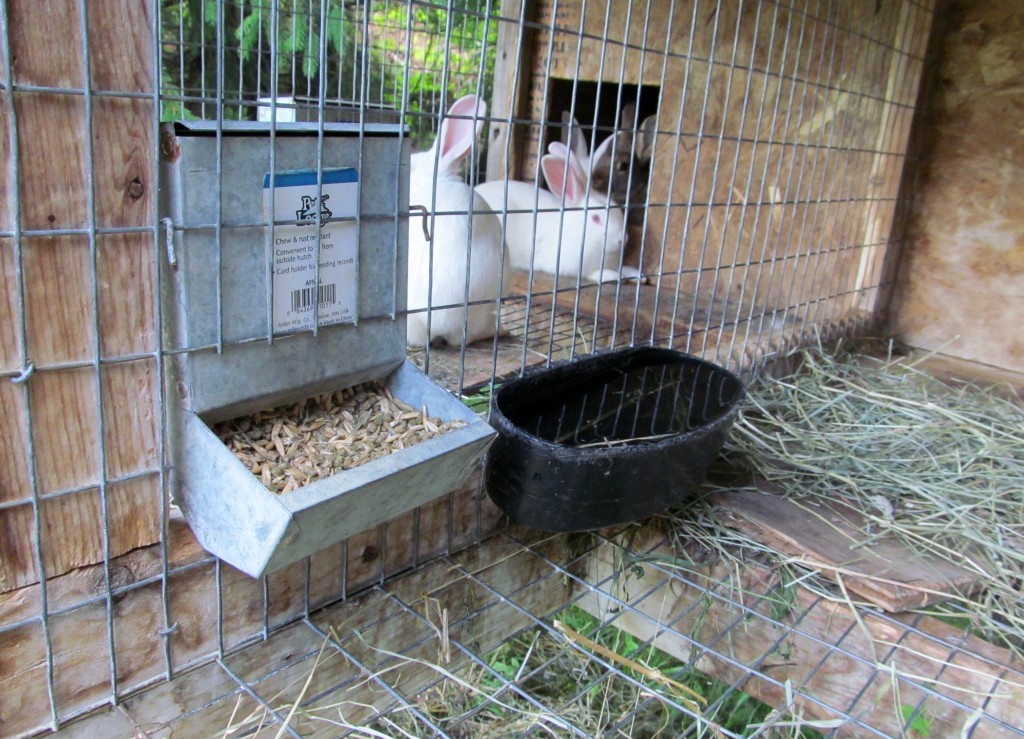Do you live on a small farm or have limited acreage but are interested in raising your own source of meat? Rabbits may be for you! Rabbits can produce a great deal of meat, require only a small amount of space, and require less physically demanding work than many other types of livestock. If you are in a city lot or other urban environment, a couple of rabbits will not be loud, smelly, or disruptive to neighbors.
Over the next couple of weeks I will continue with a short series of articles dedicated to the raising of these very productive animals. First, we will begin with choosing a breed and housing your new rabbits. The most common rabbit breeds you will see are the New Zealand and the Californian. These two breeds are very productive, give birth large litters, and grow to a butchering size quickly. They are docile and good mothers. You can’t go wrong with these tried and true animals. Many producers are also successful with crosses of these two breeds and either would be a good way to start.
Want to step off the beaten path and try a different breed? If you are interested in raising heritage breeds check out “The Livestock Conservancy (http://www.livestockconservancy.org/).” This organization is dedicated to the preservation of heritage breeds of livestock, rabbits included. At this site you can view a list of the breeds that are considered heritage, learn their history, and potentially find breeders.
When I first decided to get started with a handful of meat rabbits, I hand planned on just raising these animals for home consumption. After a couple friends found out what I was planning, they also wanted to enjoy the lean, tasty meat. Even with this demand for additional meat, I wasn’t going to be a large producer and had more flexibility. I decided to try a heritage breed. A neighbor had a breed called “Lilacs” which were bred for their pelts and meat production, while also being known for their cold hardiness. I decided on this breed, but soon discovered a big drawback of purebred heritage breeds…the price! These were easily double what I would have spent on a common commercial breed. One other drawback is the limited gene pool. You may find it more difficult to find unrelated individuals for your breeding stock.
I still decided to give the Lilac breed a try. Although I am just beginning, I found my limited number of animals to be good mothers, hardy, and friendly. For me, meat production is the number one priority, but I also wanted a rabbit that had eye appeal. For me, this was the breed that provided that for me.
Rabbits can be housed in barns or in outdoor hutches, but consideration needs to be given to weather. In warm weather, rabbits can easily overheat. In cold weather it’s important that your rabbits have a clean, consistent source of water and feed, and a place to get out of the cold and wind. All wire cages (generally ½ inch wire spacing is best) are the easiest if you are in a barn, as droppings fall through the floor, keeping your rabbits clean. Under this you can have dirt flooring- which absorbs urine, or concrete. If you have hutches, wire is also used, but you also will need a sturdy roof, a place for the rabbits to get out of bad weather, and it needs to be predator proof.

Rabbit watering systems can be as water bottles or open waterers, as pictured. The drawback of the open watering system is the contamination potential. I often find rabbit feed and manure in the water, although these rabbits seem to prefer drinking out of the open container rather than the bottle. The feeder pictured allows feed to always be available and cleanly. Also note the wire spacing in this picture. It is much too large and needs to be changed to allow for greater comfort of the rabbits.
Continued in our next edition–what do we feed and breed our new rabbits? Stay tuned!



Hello Anil! If you would like to receive information from one of our educators, please head over to http://ccerensselaer.org/contact. You can fill out a quick form with your request, and someone will be in touch with you to discuss your questions. Thanks for reading and commenting!
Want training to start Rabbit Farm